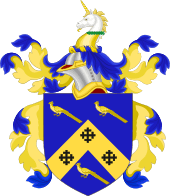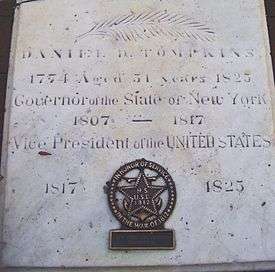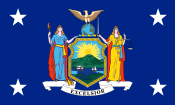Daniel D. Tompkins
| Daniel D. Tompkins | |
|---|---|
 | |
| 6th Vice President of the United States | |
|
In office March 4, 1817 – March 4, 1825 | |
| President | James Monroe |
| Preceded by | Elbridge Gerry |
| Succeeded by | John C. Calhoun |
| 4th Governor of New York | |
|
In office July 1, 1807 – February 24, 1817 | |
| Lieutenant |
John Broome DeWitt Clinton John Tayler |
| Preceded by | Morgan Lewis |
| Succeeded by | John Tayler (Acting) |
| Personal details | |
| Born |
Daniel D. Tompkins June 21, 1774 Scarsdale, New York, British America |
| Died |
June 11, 1825 (aged 50) Castleton, New York, U.S. |
| Resting place | St. Mark's Church in-the-Bowery |
| Political party | Democratic-Republican |
| Spouse(s) | Hannah Minthorne |
| Children | 8, including Minthorne |
| Alma mater | Columbia University |
| Signature |
|
Daniel D. Tompkins (June 21, 1774 – June 11, 1825) was an American politician. He was the fourth Governor of New York from 1807 to 1817, and the sixth Vice President of the United States from 1817 to 1825.
Born in Scarsdale, New York, Tompkins practiced law in New York City after graduating from Columbia College. He was a delegate to the 1801 New York constitutional convention and served on the New York Supreme Court from 1804 to 1807. In 1807, he defeated incumbent Morgan Lewis to become the Governor of New York. He held that office from 1807 to 1817, serving for the duration of the War of 1812. During the war, he often spent his own money to equip and pay the militia when the legislature wasn't in session, or would not approve the necessary funds.
Tompkins was the Democratic-Republican Party's vice presidential nominee in the 1816 presidential election. The ticket of James Monroe and Tompkins easily prevailed over limited Federalist opposition. He served as vice president from 1817 to 1825, and was the only 19th century vice president to serve two full terms. In 1820, he sought another term as Governor of New York, but was defeated by DeWitt Clinton. After the War of 1812, Tompkins was in poor physical and financial health, the latter condition stemming largely from his spending for the military effort during the War of 1812. He fell into alcoholism and was unable to re-establish fiscal solvency despite winning partial reimbursement from the federal government in 1823. He died in June 1825, soon after leaving office.
Name
Tompkins was baptized Daniel Tompkins, but added the middle initial "D." while a student at Columbia College to distinguish himself from another Daniel Tompkins who was a student there. There is controversy as to what the middle initial stood for; some have suggested "Decius."[1][2][3] The generally accepted conclusion is that it did not stand for anything, and served only to distinguish him from the other Daniel Tompkins.[4][5][6][7]
Early life, family, and career
Daniel D. Tompkins was born in Scarsdale, Westchester County, New York, at his home, the estate of Fox Meadow.[8] He was the son of Sarah Ann (Hyatt) and Jonathan Griffin Tompkins. His older brother, Caleb Tompkins was a United States Representative from 1817 to 1821. Daniel Tompkins graduated from Columbia College in New York City in 1795, and then studied law with James Kent and Peter Jay Munro.[9] He was admitted to the bar in 1797, and practiced in New York City.[10] Despite the Federalist leanings of Kent and Munro, Tomkins entered politics as a Democratic-Republican.[10] He was a delegate to the New York State Constitutional Convention in 1801, and a member of the New York State Assembly in 1804. He was elected to the 9th United States Congress, but resigned before the beginning of the term to accept, at age 30, an appointment as associate justice of the New York Supreme Court, in which capacity he served from 1804 to 1807.
On February 20, 1798, Daniel Tompkins, 23, married 16-year-old Hannah Minthorne, the daughter of Mangle Minthorne, an Assistant Alderman of New York City.[11][12] The couple had eight children, including Arietta Minthorn Tompkins (born July 31, 1800), who married a son of Smith Thompson in 1818, and (Mangle) Minthorne Tompkins (December 26, 1807 – June 5, 1881), who was the Free Soil Party candidate for Governor of New York in 1852. Their children Hannah and Minthorne were named after their mother, and Hannah and Minthorne streets in Staten Island are named for them.[13] Hannah was ill in the year before her husband became vice president, and did not attend his inauguration.[14] She survived him by nearly four years in Tompkinsville, Staten Island.
Governor

On April 30, 1807, he defeated the incumbent Governor Morgan Lewis – Tompkins received 35,074 votes, Lewis 30,989 – and remained in office as Governor of New York until 1817. He was reelected in 1810, defeating Jonas Platt – Tompkins 43,094 votes, Jonas Platt 36,484. In 1813 he defeated Stephen Van Rensselaer – Tompkins 43,324 votes, Van Rensselaer 39,718 – and in 1816, he beat Rufus King – Tompkins 45,412 votes, King 38,647. Tompkins was supported by DeWitt Clinton in his first run for office, but Tompkins later broke with Clinton by supporting James Madison over Clinton in the 1808 presidential election.[15]
During the War of 1812, Tompkins proved to be one of the most effective war governors. He played an important role in reorganizing the state militia and promoted the formation of a standing state military force based on select conscription. He declined an appointment as United States Secretary of State by President James Madison in 1814, instead accepting appointment as commander of the federal military district that included New York City.[16]
Tompkins was also elected a member of the American Antiquarian Society in 1814.[17]
In 1815 Tompkins established a settlement along the eastern shore of Staten Island that came to be called Tompkinsville. He built a dock along the waterfront in the neighborhood in 1817 and began offering daily steam ferry service between Staten Island and Manhattan. In 1816 he purchased much of the land later known as Tompkinsville from the Church of St. Andrew, but his financial troubles later led the church to foreclose. His son-in-law and daughter, Dr. John S. and Hannah Westervelt then bought the property, which they later divided into many lots to sell off.
In 1817, Governor Tompkins suggested that July 4, 1827, be set as the date on which all slaves in New York state—including those who were born before the Gradual Manumission Act of July 4, 1799, (and who were therefore not eligible for freedom)—should be freed.[18]
Vice president
Many New York Democratic-Republicans supported Tompkins for president in the 1816 presidential election, but James Monroe received the party's nomination.[15] Tompkins was instead elected as Monroe's running mate, and Tompkins won reelection in 1820, serving from March 4, 1817, to March 4, 1825. In 1820, while serving as vice president, he ran for Governor of New York against incumbent DeWitt Clinton. The election was held in April 1820; Tompkins lost. He received 45,900 votes while Clinton received 47,447. In 1821, he was a delegate to the New York State Constitutional Convention, serving as its president.[19]
Tompkins entered in office in poor health, the result of a fall from a horse on November 3, 1814. Tompkins's finances were also quite poor, as Tompkins had borrowed money to finance the war effort during the War of 1812, and Tompkins slipped into alcoholism. Tompkins had failed to adequately document his expenses, and both the New York legislature and the federal government refused to fully reimburse him. With poor physical and financial health, Tompkins spent much of his vice presidency outside of Washington, D.C., and Tompkins made for a poor presiding officer of the Senate while it debated the Missouri Compromise in 1820. In 1823, Tompkins finally won compensation from the federal government, but he continued to drink heavily and was unable to resolve his business affairs.[15]
He died in Tompkinsville on June 11, 1825, 99 days after leaving office, and was interred in the Minthorne vault in the west yard of St. Mark's Church in-the-Bowery, New York City, as was his wife.[14] His post-vice presidency lifespan is the shortest of any vice president, and he also lived the shortest life of any Vice President. He was the youngest person to become Vice President until John C. Breckinridge, and the only 19th century vice president to serve two full terms under the same president.
Tompkins was the second vice president to serve two full terms, after John Adams, who was George Washington's vice president from 1789 to 1797. He would be the last to do so for nearly a century, until Thomas R. Marshall, who served under Woodrow Wilson from 1913 to 1921. (Since Marshall, John Nance Garner, Richard M. Nixon, George H. W. Bush, Al Gore, Dick Cheney, and Joe Biden, have done so as well. Apart from Garner, they all left the vice presidency at the same time as the president they had served under.)
Legacy

Tompkinsville, a neighborhood on Staten Island, is named for Tompkins. There is also a Masonic lodge in the town named for him. Tompkins is credited with being one of the founding members of the Brighton Heights Reformed Church on Staten Island. The church was founded in 1823, during his term as vice president. Its first meeting place was in what was known as Quarantine, a predecessor of the facility on Ellis Island.
Four forts in New York State in the War of 1812 were named for Governor Tompkins, in Staten Island, Sackets Harbor, Buffalo, and Plattsburgh.
Tompkins County in New York, Tompkins Square Park in Manhattan, Public School 69 Daniel D. Tompkins School in Staten Island, and the Town of Tompkins are named after him, as is Tompkins Road, running between Post Road (NY-22) and Fenimore Road in Scarsdale, New York. Tompkinsville, Kentucky, is named for Tompkins. It is the county seat of Monroe County, Kentucky, which is named for the president under whom Tompkins served as vice president. Tompkins Park in Bedford Stuyvesant Brooklyn, NY (now called Von King Park) was named after Daniel D. Tompkins[20] Also the nearby Tompkins Avenue and Tompkins Public Houses are named after the same.
Tompkins was Grand Master of the Grand Lodge of New York in 1820 and 1821. The Daniel D. Tompkins Memorial Chapel at the Masonic Home in Utica, New York was built in his honor in 1911.[21] The Grand Lodge of New York celebrated the Centennial of the chapel on June 25, 2011.[22][23]
Tompkins was mentioned by Kris Kringle in the 1947 film Miracle on 34th Street. The screenplay was incorrect, however, in that Kringle mentions that Tompkins served as vice president under John Quincy Adams when Adams's vice president was actually John C. Calhoun. (Tompkins was the 6th vice president and Quincy Adams was the 6th president, leading to confusion in the script).[24]
References
- ↑ Publishers weekly, Volume 195, Part 2. New Providence, New Jersey,: R.R. Bowker Co. 1969. p. 100.
- ↑ Fredriksen, John C. (2000). Green Coats and Glory: The United States Regiment of Riflemen, 1808–1821. Youngstown, NY: Old Fort Niagara Association. p. 29.
- ↑ New York State Historical Association (1920). "Governor Tompkins' Middle Name". State Service: An Illustrated Monthly Magazine Devoted to the Government of the State of New York and its Affairs, Volume 4. Albany, NY: State Service Magazine Co., Inc.: 502.
- ↑ Winchester, Charles M. (February 1, 1920). "New York's Forty-Four Governors". State Service: An Illustrated Monthly Magazine. Albany, NY: State Service Magazine Company: 147.
- ↑ Winchester, Charles M. (June 1, 1920). "Governor Tompkins' Middle Name". State Service: An Illustrated Monthly Magazine. Albany, NY: State Service Magazine Company: 502.
- ↑ Skinner, Charles R. (1919). Governors of New York from 1777 to 1920. Albany, NY: J. B. Lyon Company. p. 2.
- ↑ Smith, Henry T. (1898). Manual of Westchester County. 1. White Plains, NY: Henry T. Smith. p. 246.
- ↑ "FOX MEADOW SALES. First Break Made Into Famous Westchester Estate", New York Times, April 3, 1921, p.76
- ↑ Cox, Thomas H. (2009). Gibbons v. Ogden, Law, and Society in the Early Republic. Athens, OH: Ohio University Press. p. 92. ISBN 978-0-8214-1846-8.
- 1 2 Gibbons v. Ogden, Law, and Society in the Early Republic, p. 92.
- ↑ Irwin, Ray W. Daniel D. Tompkins: Governor of New York and Vice President of the United States, p. 27 (1968)
- ↑ (3 March 1798). Marriages, The Weekly Magazine, p. 160 (1798)
- ↑ Platt, Tevah (3 June 2010). Neighborhood still memorializes Daniel Tompkins, Staten Island Advance
- 1 2 Dunlap, Leslie W. Our Vice-Presidents and Second Ladies, p. 32-34 (1988)
- 1 2 3 "Daniel D. Tompkins, 6th Vice President (1817–1825)". US Senate. US Senate. Retrieved 22 October 2015.
- ↑ Spencer C. Tucker, The Encyclopedia Of the War Of 1812, 2012, page 713
- ↑ "MemberListT".
- ↑ White, Shane. Somewhat More Independent: The End of Slavery in New York City, 1770–1810. University of Georgia Press, 1991. pp. 53–54
- ↑

- ↑ "Herbert Von King Park".
- ↑ "Tompkins Chapel was built in 1911 in memory of Most Worshipful Daniel D. Tompkins, Grand Master of Masons in 1820". MasonicHomeNY. Retrieved 2011-10-26.
- ↑ "The Centennial of the Daniel D. Tompkins Memorial Chapel". Retrieved 2011-10-26.
- ↑ "Centennial of the Daniel D. Tompkins Memorial Chapel" (PDF). Retrieved 2011-10-26.
- ↑ "The Making of Miracle on 34th Street, 50th Anniversary Edition" (Sindpiper Publishing), 1997
External links
![]()
- "Daniel D. Tompkins". Find a Grave. Retrieved August 28, 2010.
- United States Congress. "Daniel D. Tompkins (id: T000306)". Biographical Directory of the United States Congress.
- Public papers of Daniel D. Tompkins, governor of New York, 1807–1817, Volume 3 (online)
| Party political offices | ||
|---|---|---|
| Preceded by Morgan Lewis |
Democratic-Republican nominee for Governor of New York 1807, 1810, 1813, 1816 |
Succeeded by DeWitt Clinton |
| Preceded by Elbridge Gerry |
Democratic-Republican nominee for Vice President of the United States 1816, 1820 |
Succeeded by John C. Calhoun Albert Gallatin (Withdrew) Nathan Sanford¹ |
| Political offices | ||
| Preceded by Morgan Lewis |
Governor of New York 1807–1817 |
Succeeded by John Tayler Acting |
| Preceded by Elbridge Gerry |
Vice President of the United States 1817–1825 |
Succeeded by John C. Calhoun |
| Academic offices | ||
| Preceded by Morgan Lewis |
Chancellor of the University of the State of New York 1808–1817 |
Succeeded by John Tayler |
| Notes and references | ||
| 1. The Democratic-Republican Party split in the 1824 election, fielding four separate candidates. | ||

